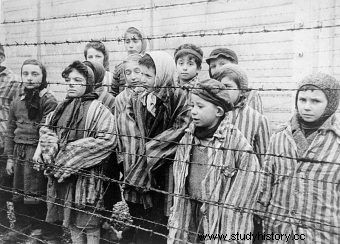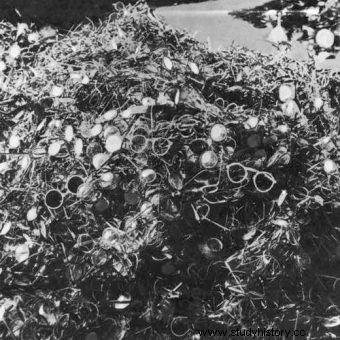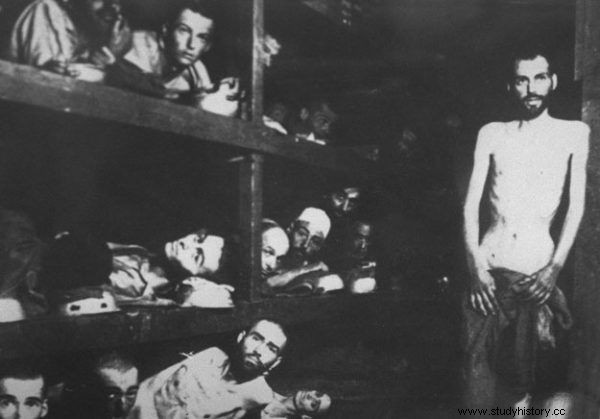The Red Army liberated Auschwitz on January 27, 1945; on the spot she found demolished crematoria and only a few thousand prisoners. All camp records have disappeared. However, there were traces of what happened in the camp. Many warehouses have been destroyed, but hundreds of thousands of men's and women's clothing have been discovered among the remains of Canada, as well as over 7 tons of human hair obtained for wigs.
As news was flooding in from all fronts at that time, the Washington Post and the New York Times published the first articles mentioning, for example, Auschwitz only two months after the liberation of the camp. However, they did make terrifying accounts of April 4, when the US 4th Panzer Division arrived at Ohrdruf, a sub-camp of Buchenwald, where guards killed many of those who were not taken out of the camp.

Children behind the barbed wire of the camp. Still from the Soviet film documenting the liberation of Auschwitz
Visiting the site a week later Generals Dwight Eisenhower and George Patton were guided by former prisoners who showed them the half-burned bodies of the dead and shot . Patton refused to go into the shed full of the corpses of starving people as he feared he would throw up.
No information?
The sight was terrifying - piles of dead and dying, not on the battlefield, but behind barbed wire in the mud of a concentration camp. Photos and videos shocked the world. Detailed descriptions of the functioning of the camps have been circulating for some time, however. The report sent through the Polish underground stated that seven hundred thousand Jews were shot with machine guns, killed with hand grenades and gassed in mobile chambers. This document, widely discussed in Western newspapers, appeared in 1942, that is, in the first months of the Holocaust and almost three years before the end of the war.

The article is an excerpt from the book A Night That Doesn't End. History of concentration camps Znak publishing house
The problem was not at all the lack of information about the camps, as can be clearly seen in the editorial comment attached to the report in the New York Times; it stated that the sources of the report were reportedly credible, but "the stories it describes seem too terrible and the atrocities too inhuman to be true" . The Polish underground sent a courier Jan Karski to London and Washington to tell him what he had seen in the death camps. US Supreme Court Justice Felix Frankfurter memorably expressed his skepticism then: I did not say that this young man was lying. I said I couldn't believe him ” .
In 1943, credible reports appeared in newspapers that over three million civilians had been killed in Poland. The truth was: Western societies had enough information to realize that something terrible was going on in the concentration camps , but proved unable to imagine that all of this was true.
Later, it was asked why many of the people sent to the camps seemed resigned to their fate. It would be more useful to consider why prisoners of war during World War I showed a similar attitude decades earlier. During the previous conflict, French and English newspapers were full of horrific stories about concentration camps, although some of these accounts later turned out to be untrue. Even so, when summoned to register and then report to the camps during that war by citizens of hostile countries, they generally did so without resisting. They were called monsters on the street and many journalists spat and slandered them. But they knew they were innocent, and they hoped that while the government did not trust them as a group, it would not misrepresent them as individuals. The war will end and they will be released. This is what they expected, and with a few exceptions, it happened exactly. The operation of a concentration camp in this version was watched around the world only two decades earlier.

Railroad tracks, guardhouse and main gate of Auschwitz II (Birkenau), view from the ramp inside the camp, 1945
Although the Stalinist purges were bloody, the vast majority of prisoners were finally released from the Soviet labor camps. After the horrific events of Kristallnacht, most of the Jewish prisoners detained in the Konzentrationslager were released within weeks. Both systems were frightening, but there was nothing in the recent models of concentration camps to indicate mass extermination. When rumors started spreading that the deportees were not settling anywhere, some resisted. Uprisings broke out in ghettos and prisoners in camps killed SS men. However, when it became clear that it was about extermination, it was often too late. Before the mass extermination began, the Nazis spent eight years building a network of camps and practicing torture and repression by training personnel in their brutal use. Escape became almost impossible, and acts of resistance were responded to with mass retaliation.
It is also worth remembering that while some were aware of what was happening, it was not common knowledge. On the news of the Warsaw Ghetto Uprising in the spring of 1943, Eli's mother, who was still living in the Romanian city of Syhota, asked:“Why are our Jewish brothers doing this? Why are they fighting? Could they not wait quietly for the end of the war? A year later, the passengers from Wiesel's transport finally reached the station with the inscription "Auschwitz", loaded into the carriages. They should be scared, but as he himself wrote:"None of us have ever heard that name."
The phase of liberating the camps by the Allies, which began on the Eastern Front in mid-1944, lasted until May 1945. While the sight of foreign troops at the gates of the camps was delightful, many prisoners experienced only a partial liberation from being behind the barbed wire. Forced laborers were kept for months in internment camps - until they could be sent home by train and the railroads were often destroyed or used for urgent post-war purposes. All of Western Europe was plunged into a food crisis, which made it difficult to provide adequate rations, and many people who were already sick or extremely exhausted died.
There were widely publicized pogroms of Holocaust survivors in Poland, so many Jews from there and elsewhere were unwilling or unable to return home. Hundreds of thousands of people ended up in camps for displaced persons (so-called DPs) in Germany, Austria and Italy. Although these camps had little to do with the Konzentrationslager, many people waited months or years there without knowing their future fate.
After triggering…
Even those former prisoners who had been released from the camps were not always free. In post-war Germany, Roma and Sinti continued to struggle with prejudices and legal restrictions. Laws criminalizing homosexuality also continued, making it difficult for gay survivors to talk about their stay in the camps and their reasons for going there; nor did they mention compulsory sterilization. Krystyna Żywulska, who was born Sonia Landau, kept her assumed name after leaving Auschwitz, without revealing that she was Jewish for almost twenty years. The fact that she could have had good reasons for this was evidenced by the fact that she was finally expelled from the Union of Polish Writers as part of the "anti-Zionist" purge.
Margarete Buber-Neumann, having survived both the gulag and the Nazi camp, testified about her experiences in the Gulag during a defamation case brought by a communist French newspaper by an emigrant from the USSR, which tried to discredit him. She herself was defamed by a German reporter who denied the truthfulness of her account with the Soviet Union and stated that she sympathized with the Nazis. She only won the case in the German Supreme Court. Her anti-Soviet crusade became famous and she herself was under surveillance by the East German Stasi secret police.
Other post-war lawsuits were of greater historical importance. During the Nuremberg trials in 1945, the first charges were brought against "crimes against humanity" . Prosecutors of the International Military Tribunal in Nuremberg accused a group of people of such crimes - those who planned the war and those who pursued anti-Semitic policies. Twelve death sentences were handed down and seven defendants were sentenced to terms ranging from ten years in prison to life imprisonment. During the Neuengamme crew trials in Hamburg in March 1946, the British tried fourteen men before a two-month military tribunal, with eleven death sentences and three sentences ranging from ten to twenty years in prison.
After the Auschwitz trial in Krakow in 1947, twenty-one former camp staff members were hanged and eighteen sentenced to prison terms :from three years to life. More than seventy years after the end of the war, sentences are still handed down in trials of individual perpetrators:in June 2016, former Auschwitz guard Reinhold Hanning was sentenced to five years in prison.
The total number of Jewish victims of the Holocaust has totaled around six million. Seven million Soviet civilians and nearly two million non-Jewish Poles were also killed, as well as some two hundred thousand Roma and Sinti. As with almost every concentration camp system, we do not have a record of the total number of deaths. Apart from Auschwitz-Birkenau and the death camps where nearly three million Jews were murdered, about seven hundred thousand people were killed in the Konzentrationslager system out of one million two hundred thousand prisoners of all races and nationalities, the vast majority of whom died after the outbreak of the war.

Glasses of those murdered in the camp (photo from 1945).
Today, on the site of the former Auschwitz camp and in the nearby Birkenau, there is a museum visited by over a million people every year. Restaurants across the road invite tours and individual visitors by displaying boards describing their specialties. As with most sites commemorating the Nazi camps, there is a bookstore with memories, scientific studies and collections of documentary photos. Guided tours are offered in seventeen languages, and there is a snack kiosk at the entrance to the former camp. However, none of these elements weaken the influence of the place.
In 2013, the World Holocaust Remembrance Center, Yad Vashem, created an exhibition that was arranged in block 27 of the Auschwitz main camp and is still there. It aims to commemorate the victims, and one of its components is a room dedicated to one and a half million children who died in the Holocaust. In an unremarkable part of the former camp, at the end of the tour, visitors come across a room with a book with the names of the deceased placed at chest height. The black rack is about two meters high and about six meters long, but thousands of white pages sticking out from both sides like wings take up almost the entire room and seem to float in the air.
The cards have the names of all the Jewish victims of the Holocaust who have been collected so far. At the time of writing this text, the book contains over four million two hundred thousand entries. There are five hundred on each page, each with the city of birth, date of birth and death, and place of death. The surnames are arranged alphabetically. When we turn pages looking for someone, we see not only information about the dead, but also the bright light that shines from the center of the book, illuminating each page.
While this form of commemoration is beautiful and moving, it seems almost cruel to keep the names of the victims locked up in block 27 forever. At the same time, however, it is necessary to prevent the loss of details in the midst of an abstract tragedy, saving also the place where it happened from oblivion; therefore they remain recorded where the most terrible crime of modern times has been committed.
After World War II, concentration camps became a symbol of genocide. The fact that they were not really necessary to commit it was proved by the deaths of over a million East European Jews in forests and over pits turned into mass graves - they were killed by mobile firing squads or the enthusiastic local population during the pogroms. However, the Nazi extermination camps gained particular fame for being associated with something unprecedented:the systematization of killing, the desensitization of killers, and an efficient bureaucracy of executions.

In Auschwitz, the Germans killed at least 1.1 million people
The number of victims and the cruelty of Nazi methods so captured the imagination that the other concentration camp systems were pushed to the background. It is easy to believe that the entire Nazi complex that included both the Konzentrationslager and the extermination factories was unique not only in its final apocalyptic stage, but also in its beginnings. In fact, what happened in Germany started in a familiar way.
As in the case of the Gulag and the camps of World War I, the preventive arrests of thousands of people identified as a threat to state security resulted in the establishment of the institution of arbitrary detention of people. In the case of Nazi Germany, this system was driven by tyranny, and it in turn normalized brutality; over time, in terror and keeping people out of trial, it was possible to go further than anyone could have imagined before. Under Hitler and Himmler, the concentration camps used the progress made by mankind over the centuries - modernization and civilization - to transform it not into a glorious but a shameful thing.
Seeing the height of the horror in the form of the death camps, the people swore:"Never again" . However, the concentration camps as such have not disappeared, but have multiplied. The gulag was still operational and not yet at its peak, and in Africa and Asia, new camp systems were to be developed in just a few years, holding millions of prisoners.
The article is an excerpt from the book The Night That Doesn't End. The history of concentration camps published by Znak Publishing House
